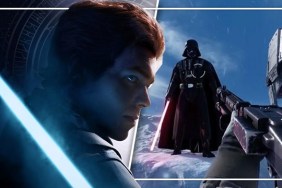Where’s the Mechanical Man?
It has been many years since the first Tiberian war. In the interim, Tiberium
has shown itself to be an aggressive, relentless, systematic, climate-altering
mechanism. The discovery of a crashed alien spacecraft, one that seems to be inextricably
linked to Tiberium, has raised more questions than it has answered. Is Tiberium
a biomechanical terra-forming agent? Does some distant intelligence have designs
on the Earth? Is a Tiberian world our inescapable future? On top of that, Kane,
years after his supposed death at the hands of the GDI Ion Cannon in his Nod Temple,
has returned with a plan to conquer the world once again. There is little certainty
here, only this: the war is on, and this time the very biological character of
the planet hangs in the balance.

Four years ago, the gaming world was stunned with the release of Command
& Conquer: Tiberian Dawn. Following up on the seminal real-time strategy
game Dune II, C&C polished the RTS formula to the hilt. For many
gamers, C&C was the first RTS they ever played. It was the definitive
addiction, causing loss of a social life and fitful dreams filled with Mammoth
Tanks, Obelisks of Light, and Orca attack helicopters. Included in the original
C&C was a preview, showing a rendered cut-scene of a unit that never
made it into C&C as a teaser for the planned sequel, Command & Conquer:
Tiberian Sun (C&C 2).
Now, four years and one prequel (Red
Alert) later, C&C 2 has finally arrived. As one of the most hotly
anticipated games ever produced, expectations for C&C 2 are, understandably,
so high that only if it was the biblical messiah of RTS games could it meet
them. Command & Conquer: Tiberian Sun, much like Starcraft
before it, achieves much more modest, though still respectable, success. C&C
2 is not revolutionary; it will not show you anything you have not seen
before. It does however, contain solid, refined gameplay that will feed the
appetites of the millions of C&C fans who cannot wait any longer to return
to the land of the GDI, the NOD, and green Tiberian pastures.
The most obvious change in C&C 2 is the move to a 3D, isometric view
of the battlefield. Gone are the days where cliffs were merely set dressing
and the world was predominantly flat. In C&C 2, not only is there an
incredible variety of environments in which you wage war, but those environments
also show the effects of the battle. This allows for subtle gameplay strategies
never before seen in resource based RTS games. For example, instead of merely
setting up a line of turrets as a base defense, why not carve out a deep crater
in front of them, adding more length to the approach journey of attacking ground
units and giving the turrets more time to shred them into a red pulp?
The sound, much of which was taken from the original C&C, is very good. While many of the overall musical themes from C&C have been adapted in some way for the sequel, most of the music is far more ambient and mood setting that the old C&C tracks.
Command & Conquer: Tiberian Sun has also been afforded a luxurious
graphical overhaul. The new engine, which supports 3D vehicles and destructible
contoured terrain, also adds dynamic colored lighting, higher resolutions, and
a much better overall look than the previous games. However, the voxel units
are somewhat jagged, the infantry units (still based on bitmaps) leave something
to be desired, and the structures are adequately rather than exquisitely detailed.
The overall effect of the graphics is enough to carry the game and entertain
the player but still exhibits some of the roughness that characterized the previous
C&C games.

The unit balance in Command & Conquer: Tiberian Sun is another improvement
that only the observant gamer will notice. This time around, all units have
an Achilles heel that must be covered and countered if you are to succeed. This
forces successful players to use more complicated attacks. When playing multiplayer,
the prize goes most often to the more creative player, not just the one who
can crank out 50 Mammoth Tanks (which aren’t in C&C 2) and storm the
enemy base.
As for the rest, multiplayer is flawlessly supported and the extra depth in
gameplay is fully apparent in a good match over the Internet, modem, or LAN.
There is also C&C: Red Alert‘s “Skirmish” mode, a simulated multiplayer
game that works just like the custom missions of Warcraft
2 and Starcraft.
The story is skillfully presented to the gamers through many full motion video
(FMV) cut-scenes. However, the clips do not just consist of mission briefings
from the perspective of a nameless commander, but tell a more Hollywood-esque
tale. To effectively do this, Westwood hired the talents of Michael Biehn (The
Terminator, Aliens, The Rock) as GDI Commander McNeal, James Earl Jones
(Darth Vader, that CNN intro) as GDI C.O. General Soloman, and of course Joseph
Kucan (Westwood’s resident ‘scary bald guy’) as the returned Kane. The production
value of the movies is good, although not quite as high as the excellent film
segments in Wing Commander 4.
Command & Conquer: Tiberian Sun is a perfectly acceptable follow up
to an amazing game. It faithfully continues one of the most revered gaming series
and should be just fine for all the starving RTS fans out there. That aside,
C&C 2 is essentially C&C with a facelift and a few nips & tucks.
Tiberian Sun is perhaps as good as Tiberian Dawn, but it definitely
does not show four years of improvement. C&C 2 falls short, but it still
deserves your attention. And don’t worry – there are some more sequels planned.
They just better not take another four bloody years…

-
Tried and true
-
Good Depth
-
Great Production Values
-
Too Similar to its Predecessor
-
We Waited Four Years For This?







